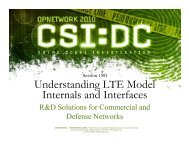Automated Axon Tracking of 3D Confocal Laser Scanning ...
Automated Axon Tracking of 3D Confocal Laser Scanning ...
Automated Axon Tracking of 3D Confocal Laser Scanning ...
You also want an ePaper? Increase the reach of your titles
YUMPU automatically turns print PDFs into web optimized ePapers that Google loves.
the <strong>3D</strong> stack. Several automatic algorithms were introduced in the past for the centerline tracking<strong>of</strong> elongated tubular objects, such as retinal vasculature (Can et al., 1999) and neurons (Zhang etal., 2006). Though being computationally efficient in tracking the centerlines, they fail to workwhen the objects seem to cross each other in the MIP image.The second category <strong>of</strong> algorithms tracks the centers by segmenting the objects in a sequence<strong>of</strong> cross-sectional images in the dataset. A popular algorithm in practice today is the snake model(Kass et al., 1987). It improves on an initial boundary by minimizing an energy functionalconsisting <strong>of</strong> internal and external energies. The authors <strong>of</strong> (Cai et al., 2006) proposed animprovement over the original snake model by incorporating a repulsive force to segment closelying cross-sections <strong>of</strong> axons. Similar to the snake model, the repulsive snake model is unable toaccurately segment the axons <strong>of</strong> blurred boundaries. Level-sets represent another approach tosegment and track using cross-sectional information, but they are computationally expensive andcan be slow to converge (Xiong et al., 2006).The final set <strong>of</strong> algorithms deploys <strong>3D</strong> methods to track the objects in volumes <strong>of</strong>microscopic data. The main advantage <strong>of</strong> these algorithms is that they can track the objectsregardless <strong>of</strong> their image orientation. The authors <strong>of</strong> (Al-K<strong>of</strong>ahi et al., 2002) built on thetemplate based approach in (Can et al., 1999). The axons over short distances were modeled ascylinders with elliptical cross-sections having a certain curvature. Four sets <strong>of</strong> directionaltemplates were used to track the centers <strong>of</strong> the axons in each iteration. Another approach wasintroduced in (Tschirren et al., 2005), where the authors used fuzzy connectivity forsegmentation and analysis <strong>of</strong> intra-thoracic airway trees. The dataset was analyzed iterativelyinside a moving cylindrical region <strong>of</strong> interest. Inside this cylinder, two regions, foreground andbackground, were grown simultaneously to compete for voxels. The centerlines could then be4















